Hokepoints Reps Inside Zone

By the end of this article you should be able to make an educated guess
as to what Braden is saying to A.J. Williams [Fuller]
You may have heard Michigan has a new offensive identity, by which of course we mean Michigan now has an offensive identity. We think. We're told. Evidence for this is Michigan hired a new OC who runs inside zone, and he has even Brady Hoke talking about it being our base thing. This thing is totally happening. I mean if they hadn't sworn up and down for three years that Power was going to be their thi...
Let's just not go into that and focus on inside zone and how to watch inside zone, and how to be correctly disappointed with the correct person when inside zone isn't run very well. Since this is a new thing, and the offensive line are all relatively new things themselves, and the recent history of Michigan football has given you no reason to believe otherwise, and there are some really good defensive linemen Michigan has to go against this year, let's concede right now that Michigan isn't going to be running inside zone very well this season, especially early. Let's pretend like the coaches are going to stick it out anyway and let it play out.
IZ Resources: As well as the above-linked articles, I drew from Chris Brown at Smart Football, and this article that quotes Chris Brown on a Philly Eagles website. And Space Coyote wrote an entire article on IZ and some plays that stem from it in this year's HTTV; I'm sure he'll pipe in as soon as I mess something up here.
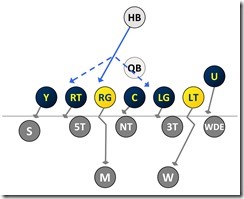 |
| Every blocker is responsible for whatever defender appears in the "zone" he's responsible for blocking. |
A Temperate Zone
What's inside zone? Maybe it's best to start with what it's not: man. In MANBALL, most linemen have an assigned guy to block; a lead blocker (sometimes a puller) is the only dude who has to make a tough, mid-play decision, and the running back just has to follow that guy.
Inside zone is a base running play where all the blockers are reacting to the defense, not just a lead guy, and the running back has to choose from among various holes that could open up. It takes a different set of skills, mastery of a different set of blocks, and most of all: reps reps and more reps so that everybody can make split-second decisions and those decisions will be correct.
That's not to say all decisions are made after the snap. In fact most blocking assignments are determined by how the defense is lined up. In many cases it won't be all that discernible from man-blocking.
yellow is uncovered. click bigginates.
The read OL have to make is whether they're "covered" or not. Covered means there's a DL lined up across from you. If there isn't, you are "uncovered" and most likely you'll get to go hunting linebackers. But first you look next to you and see if there's a defender shaded to the playside of your buddy; he may need help with that lineman before you release downfield. If that defender is a beast your buddy may need all the help he can get. You deal with the first level defenders before you worry about stopping linebackers.
Almost always, more than one defender will arrive in a blocker's zone. So zone blocking means lots of shared blocking. Ultimately the blocking ends up being 2-on-2 instead of 1-on-1. For example in captioned illustration above-right, the center and right guard are together responsible for blocking the nose tackle and the middle linebacker.
Footwork Impeccable
Offensive linemen in high school seldom get the right footwork down. Zone-blocking footwork isn't the same as pile-driving some dude, for one; and two it's not something many high school coaches know how to teach; and three if you're a 6'6"/300 future Big Ten OL and your job is to block a 6'0"/180 future Big Ten economics major, your greatest motivation to pay attention to your feet is probably the preservation of your prom date's.
In this moment it matters greatly. You need to get off the snap, get playside of your defender, get downfield, and get your feet set beneath you, your hands inside, and your pads beneath his so you can ride him out of the play, stonewall him, or shove him downfield; you let him dictate his fate.
On inside zone, an uncovered guy's first step is always to the play-side, not directly toward the guy you're going to block (the OL taking this step is a good indicator it's a zone-blocked rather than man-blocked play). This is because the DL don't always come straight upfield; you don't want them running by you.
Your job is to block the guy trying to cross you. If someone lined up inside you and ran further inside you, he's not yours. Your head stays downfield until you lock on a target, and any object that attempts to cross your field of vision must be stopped.
That Rabbit's Dynamite
Interesting example of a 1) a cutback and 2) the U starting on the strongside of the formation then executing his backside block almost like a lead blocker
Mastering the combo blocks and footwork to respond to all the things defenses throw at you takes a bazillion reps. The upside: inside zone, like option offenses, is a multi-attack threat that can go where the defense doesn't. A called IZ play could end up going outside, or inside, or cut to the backside depending on how your opponent defends it. A well-run IZ offense doesn't let defensive fronts play aggressively; if they want to stop you they'll have to activate the safeties in the run game, opening up the pass. It's not wimpy; it's smashmouth football that—as you'll see—relies mostly on crushing blocks to break things big.
[After the jump I'll show some sample executions versus various defensive alignments so you can get a sense of how it attacks and what factors lead to its success.]
Sample Play One: Null
The above gif resembles a typical inside zone play where nobody on either side does anything extraordinary or extraordinarily bad. In this case the RB has to make a tough choice because the 5-tech did a good job penetrating; the back settles for slamming it inside. Let's go through it step by step.
1. Read before the snap.
The offense comes to the line of scrimmage. While some long-haired freaky dude is still lamenting the preceding huddle, the linemen are noticing that the defense is in a 4-3 under. The tight end (Y) and the right tackle communicate that they're both covered; neither is getting help from the other. The right guard is uncovered, but the nose tackle is shaded to playside of the center. Since this nose tackle is a 330-pound man-beast who's been giving the offense a hard time all day, the center and the right guard both know that they'll have to combo the nose, with the RG releasing to pick off the MLB once the center's got the beast under control. The left guard is also covered, and is playside of the 3-tech so he feels confident. The LT is uncovered—the WDE is split out to check the U—so he's gonna help the U-back get the WDE before releasing into the WLB. The running back is already checking the DL's alignment and the blocking assignments, psyching himself to spot his hole.
2. Footwork and Combos
Here's where the footwork comes into play. The experienced line has taken their exact correct steps to reach the line of scrimmage set to take on blocks. The Y-tight end is in good position to kick the SAM out of the hole, the right tackle has a shot to seal the 5-tech, the RG and C are, for the moment, doubling that nasty nose tackle. The left guard too has gotten playside of the 3-tech. The LT is giving a shove to the WDE before he releases; hopefully the U-tight end will be able to knock that dude back in a sec. The RB is receiving the handoff; the linebackers stay back respecting play-action.
3. Decision Time
The handoff has been made; the linebackers are activated. That Y-TE is kicking out the SAM, but the 5-tech is burrowing into the RT, able to threaten either side at the moment. The RG and C have finished their combo and the RG has left seeking to hit the MLB before he gets to the hole. The RB isn't looking at the backside cut yet; he sees a hole will open up to whichever side of the right tackle the 5-tech doesn't choose. The RB decelerates momentarily to let this play out, hoping the blocks hold.
4. Execution
The 5-tech flinches; he has to protect the "C" gap and trust the MLB and NT can close off the "B" gap. From here it's all on the players: how fast can the RB accelerate into the hole—fast enough that the 5-tech can't fight back, or the MLB arrive to fend off the RG's block? How well can the RT, RG, and C maintain those blocks and give the RB room to run top speed vs having to pick his way over the feet and asses of his linemen? What if the guard can devastate the MLB here, blocking him into the WLB's pursuit or even a closing safety? Being technically good gets you so far; having great athletes can make a huge difference in these little half-seconds.
5. Result
The RB hit the hole but the RG left the NT too late to really put a block on the MLB, and that guy makes an ankle tackle, with the RG falling on him in turn. Three yards for the offense. That nasty 330-lb. NT is a real troublemaker; every millisecond he was occupying the uncovered blocker, the MLB was still able to flow freely to the play.
Sample Play Two: Cutback
I'm showing you the defense on this one because the other team's D.C. is sick and tired of getting run on to the strong side all day. He's going to throw the offense for a loop by aligning in a 4-3 over and slanting the line to the frontside, and blitzing the SAM atop it all, with LBs protecting backside gaps in case there's a cutback.
1. Read Before the Snap.
The RT, LG and U-tight end are uncovered. By alignment, the defense is saying "please run your IZ on me—see I left you a huge "B" gap." That's what they want you to think. The simple IZ reads don't say "go here;" they say the RT has to check the 3-tech and the LG and U-TE can release, and the other guys have to block the guy covering him.
2. Footwork and Combo
The line takes its step playside and already the slanting DL are getting all up in their bear grylls. The RT's step gave him the 3-tech but nobody's got the blitzing SAM. The RG should realize at this point that he's the free man (the 3-tech started above him and never crossed his eyes) so he's gotta look for the MLB or NT, just as he did against the under. Will he see this? The C can't handle the NT alone. The LT is also unable to control the slanting WDE and the LG has already released downfield; he sees the WDE as he goes by but our LG has been at this a long time and knows there's nothing he can do about that guy anymore, while putting a hat on the MLB could do some good if things work out behind him.
Here's where IZ creates room for a high level of player awareness to create a big play even if the play itself wasn't designed to go there. The C can't get playside of that NT, but he can add a bit of a shove to the slanting NT's momentum. And the OT can do the same with the WDE. Heave ho.
3. Decision Time
The RG spent too long figuring out who to help and so tried to shove the 5-tech so the RT could deal with the SAM. Still, the frontside is a mess. The RB looks to the backside and sees the C and LT could do nothing but shove their defenders down the line. But the guard has picked off the MLB, and the U-tight end is about to impact the poor WLB. Time to roll the dice on the cutback.
4. Execution
This might work. The NT and WDE have been shoved down the line but getting outside the backside OT is still quite a directional shift (usually a cutback goes inside that). The offense's adjustment to the defense's curveball, especially the LG's thought to go downfield, gives them a shot. In other words, the defense guessed correct and yet they could still be punished for it, but there's still a big play to be made by the RB not not just see his hole but get there.
That RB had better be able to make a sharp cut and bounce outside before the WDE regains his balance and leaps upfield to cut him off. The LT can't help much more without getting a block in the back call. The LG impacted the MLB but now that guy's fighting to get off the block and close up the hole, and the WLB has accepted the impact and is bracing to squeeze down the gap; his main duty remains not letting the RB outside of him.
5. Result
Our RB made it. The linebackers have disengaged now and they'll try to close this down after 5 to 8 yards, depending on when the safety arrives. A really fast RB might be able to zip past all of them; a tank might be really hard to bring down with such a head of steam and while still fighting off a block.
One more; you can already guess where it's going.
Sample Play Three: Run Away!
1. Read Before the Snap.
Same 4-3 under formation as the first one. I showed the defense's gap assignments; Ohio State will show this quite often with their awesome DT and DEs. A two-gapping defensive lineman is a liability if he can't control the offensive lineman he's assigned to and a major asset for the defense if he is. Inside zone doesn't get rid of that dynamic but it does put pressure on guys like this since they can't overreact to the ball. Keeping the LBs heaving involved in the run game is crucial to keeping the middle clear for the passing game, and also crucial in finding space to run.
2. Footwork and Combo
Off the snap nothing is out of the ordinary. This feels like a base defense; again the result of the individual battles will determine where the RB goes. But the nose tackle is fighting past the center already, and the DL has all established themselves past the line of scrimmage. The OL has some work to do to not get overwhelmed.
3. Decision Time
The center and RG got the NT under control and back to his side of the line. The 3-tech's penetration delayed the LT's release. The 5-tech is fighting inside the right tackle, and the LBs are still inside, having just see the handoff and reacted. It's time to redirect off-tackle—that'll teach the 5-tech to try to work inside the tackle instead of playing gap football.
4. Execution
Seeing the bounce the defenders have begun to disengage and chase. The 5-tech is suddenly past the right tackle. If the RT can spin around and get a last kick the RB should be free to hit the hole provided by the Y-TE's good block, and that RB will need all the space he can get since the RG's occupation with the nose tackle (again!) allowed the MLB to get playside, and that dude's booking for the "C" gap. Who will get there first?
5. Result
The answer is nobody since the 5-tech made a fantastic play, leaping to bring down the running back before he could re-accelerate after his bounce. This is one of the main dangers of trying the outside route that every ball-carrier is naturally attracted to. In this case it was totally the right call, and the offense executed the play pretty okay, and the defense didn't cheat down or blitz and the defense stopped him for a 1-yard loss anyway because sometimes a guy just makes a play.
Final exam: what's Braden saying to A.J. Williams?
August 5th, 2014 at 10:43 AM ^
4.5 ypc.
August 5th, 2014 at 10:44 AM ^
4.0 ypc.
August 5th, 2014 at 11:04 AM ^
how about just a ypc that isn't preceded by a minus sign?
August 5th, 2014 at 10:54 AM ^
August 5th, 2014 at 11:23 AM ^
I'll chime in more when I have time, but this is a very nice primer on the inside zone that describes it well.
I will note very quickly that the U will be working his ass off to get his helmet across the backside EMOL. Often times you'll see the backside cut block just to hold that EMOL long enough to prevent him from crashing that cutback lane. That also helps free up the backside OT to get to the 2nd level at a much better angle.
Now, the offense still needs to block based on how the defense reacts, but even in the over front the U will extend his first step parallel to the LOS in an effort to reach that backside guy. In that case, the DE is slanting heavily playside, so it'll be difficult to reach him, but that then puts the U in a much better position to seal off the LB at the next level as well.
August 5th, 2014 at 11:33 AM ^
I swear I've read a post from you somewhere that one of the first things the OL does in the inside zone scheme is 'identify the MIKE'. Am I making this up? Where does that integrate into pre/post-snap OL reads?
August 5th, 2014 at 11:57 AM ^
The MIKE must be identified to ensure all defenders are accounted for with your blocking scheme. Typically, the MIKE will be the "zero" defender, but not always. The zero defender is the defender that appears responsible for the playside A-gap, you count from inside to outside, and you must have a blocker for every playside defender. So if there are three defenders in the box playside of the "zero", you better have four blockers (including the center) playside.
The MIKE will typically set the blocks (this is done in pass pro as well) for the rest of the OL, or at least how they identify who they will release to on their doubles. If you can't account for all the blocks, you switch to the other side.
I can get into more detail later, but MIKE for the offense may not necessarily be the MIKE for the defense, it's just a way of identifying who is the "central" defender, for lack of a better term.
August 5th, 2014 at 12:16 PM ^

So here, the NT is the "zero defender". The MIKE is 1, 5T is 2, SAM is 3. Michigan has four blockers to that side, so they can run there. On the backside, WILL is 1, 3T is 2, WDE is 3. Note Michigan has 4 blockers that direction. Michigan should run left in theory, though they may have identified something that makes them want to run toward the Y (defense has poor strongside defense, poor toward the boundary, etc).
If the opponent walks up a SS into playside C gap, they can no longer account for the blocks to the right side, because NT is 1, MIKE is 2, 5T is 3, SS is 4, SAM is 5, but Michigan only has 4 blockers that direction. But they can still run left, despite there being 8 men in the box.
But, if your opponent walks up a safety in the backside D gap, then the WILL would likely be called the MIKE. The LBs may shift a bit, making it more obvious, but if the play is going right, the identified MIKE and all LBs playside must be blocked. Therefore, indentifying the MIKE sets the blocks for everyone else (and how they'll likely come off their double teams, at which angle, etc). The difference would be something like, in the diagram above, the RG calling out "Queen You" (the OT getting to the second level) rather than "Queen Me" (the OG getting to the 2nd level) if the RG and RT are combo blocking to the 2nd level.
August 5th, 2014 at 12:40 PM ^
Thank you, you answered my question wonderfully. I suppose the next quesiton is, does Nuss have in his offense the ability to check a zone run to the opposite side should the OL/QB identify that they have more blockers than defenders to one side? I certainly hope so, actually expect so for this offense, but I haven't watched enough of Bama/UW closely to know the exact nature of how much they checked the run game at the line.
It's pretty much a necessity for any zone blocking scheme. I don't know if they'll allow DG to check from a run to a pass (I kind of doubt they do, other than a hot check to an extended hand off or a fade; something safe), but they'll almost certainly allow him to dictate which side they run to in certain situations.
Now, that may be situational. It may depend on what they've seen on film and not just numbers, but they should have that ability. My guess is DG will have the ability to check right/left based on numbers (if they can't block one direction, you can run the other direction), but if the OC wants to run to the short side of the field because the defense is running cover 6 and he wants to attack the cloud leverage on the edge, he won't let DG check to the field side simply because of favorable numbers (where you can still block the short side, but have an extra blocker field side, for instance).
Seth's examples use "hard to handle" DTs as an example of these not being optimal plays. Is that the achilles heel? Is the fact that MSU's DTs are a probable weak point this year going to help this kind of run?
The MSU presumed starters are under 290lbs, or a freshman. They also transferred an OL there, so I am presuming that is a weakness. They could allow free flow to the second level by our releasing lineman.
I need to find any edge I can for hope. Another loss to MSU is a depressing thought to say the least.
Just to add to this, a beast of a defensive end may force Nussmeier to keep his U-back in the backfield or start him from the playside. That would allow the U-back to have a better angle to kick out the DE rather than counting on him to reach someone who's quick and powerful off the line.
August 5th, 2014 at 11:31 AM ^
Trick question, Braden isn't talking to Williams. He's talking to Clark and saying "Yo, you want to hit up BTB after this?"
August 5th, 2014 at 11:40 AM ^
he was saying,"Doesn't everyone know accurate has 2 c's????"
August 5th, 2014 at 11:45 AM ^
I've heard consistently that the reason we can be optomistic about the OL improving is that Nuss has simplified the offense. We've heard that the OL problems last year were more about confussion than getting beat. Seems like now instead of building on what they did know, we're going to change directions and teach something totally new.
Yikes!
August 5th, 2014 at 11:49 AM ^
August 5th, 2014 at 12:02 PM ^
It isn't entirely new. Some of the concepts may be new, Nuss may stress a bit different hand placement or verbage or things of that nature, but it isn't an entirely new concept. What will be trimmed out are the Down G and the counter trey and the things of that nature. Instead of seven or so base run schemes, Nuss will use three: Inside zone, Outside zone, Power O.
Different OCs have different philosophies on this. Meyer, for instance, used as many blocking schemes as Borges did last year. Their offense was great and their OL performed well. But their OL was very experienced as well. But Bama since Saban's arrival has kept it mostly simple: IZ, OZ, Power O, and a man blocked draw scheme (you saw this in the Day 25 Countdown to Kickoff). There are rare times where you'll see something different, but it isn't a standard part of the playbook. So it's simplified compared to some other schemes.
August 5th, 2014 at 12:19 PM ^
August 5th, 2014 at 12:31 PM ^
"Simplifying the offense" is a pretty common buzz phrase for new OCs. Like "more aggressive" is for DCs. But in the Borges to Nuss case, I think it's pretty honest considering Borges has said things like 'the pass game is an NFL passing game.' As for Kiffin at Bama? Well, I don't know how much simplier it can get besides 'we're just going to run the ball every single play', which is actually something Bama fans were asking for after Nuss' offense racked up 500+ yards in consecutive losses which is totall why Bama lost those games...
Also, I don't know how much UM's offenses will look to Bama's offenses under Nuss. Nuss ran what he did at Bama because they had that style and OL already established and he just introduced his own wrinkles and rolled with it. Plus I don't know if UM has the TEs to execute what Bama did consistantly. It might look more like what Nuss did at UW as an OC.
There are many ways to simplify things. For instance, Nussmeier's offense is simplified in terms of the number of plays and schemes. But his schemes require more in-play adjustments, reads, things of that nature. It's reps, reps, reps, reps a few things and adjust during the play.
But now they lose McCarron, and maybe the next guy up can't make some of the reads. Maybe they want to allow the WRs to just play faster, and not make reads. So instead of having a pass concept where a WR or TE breaks off his route based on a read, now that "hot" is built in. This loses some of your ability to attack downfield with slightly more complex schemes, but you're always on the same page, and playing fast because it's just about you getting to a spot. Then there are things you can simplify in pass pro (Nussmeier likes to leak a back out in a 6/7 man protection scheme, maybe Kiffen is going straight 6 man schemes with built in hots or to 7 man schemes, like Borges tried to do last year).
In both ways, you can say it's simplifying the offense, because you are simplifying certain aspects of the offense. But likewise, you probably need to add some complexity elsewhere to make up for it. Maybe overall it's more simple (I suspect it will be in Michigan's case), but you can't be too simple at this level of football. And that's how both Nussmeier and Kiffin can simplify things at their schools.
August 6th, 2014 at 10:47 AM ^
Gtfo of here with your sane and sensible logic.
August 5th, 2014 at 12:11 PM ^
August 5th, 2014 at 12:23 PM ^
I'm guessing.
That's likely more difficult for a man blocking scheme. As Seth said, it comes down to are you covered or uncovered (I would add, if we want more depth, that this differs a little for playside and backside blockers, but that's in the minutia). From there you work through your keys, your reads, and your zone.
So, let's imagine for a second that you have two initial steps, and then each linemen is on railroad tracks. On inside zone, let's say you're covered, that first step will be 45 degrees with the playside foot about to the playside shoulder of your defender. Your second step will follow (don't cross your feet) to the backside number or midpoint of the defender. Your feet are perpendicular to the LOS, and now you are attached to railroad tracks where the only way you can move is in a straight line perpendicular to the LOS. Don't chase your blocks, don't stray. If you can't get your hat across the defender's hat, the turn his shoulder and seal him outside, but keep working forward on your track. That track is your zone.
Now, it's essentially the same if you're uncovered (with different aiming points with your feet for the combo block). But you're still going to stay on your track to the next level. Any backer comes on your tracks, you run them over.
Outside zone works similarly, but your first step is parallel to the LOS, and your tracks essentially go out at 45 degrees.
So, to your question, MIKE changes things at the last second, you're still fine. Someone is still responsible for the playside A gap, you still have your counting scheme and blocking covered. And at the snap, you read covered/uncovered (if MIKE walks down, a lineman is now covered, he just treats the MIKE like a DL) and you work your feet and stay on your track. They key to all this is the OL's eyes. They need to make sure that their eyes are where they need to be, that being the 2nd level player that they are working toward. Typically that's known, you block your first level with eyes on 2nd level. If that LB twists, you should understand where a defender is coming from to fill his vacated area (someone will come, or else the defense isn't gap sound), but it's all about eye discipline, and communication/feel with your fellow blockers.
What if both LB blitz the A gaps?? I see the RG will be okay, not sure about the LG though.
First, then that NT has to clean out somewhere. He won't be in an A-gap too. He'll either have to drop or stunt into a B-gap.
And in that way the blocking scheme should pick it up. LG has A gap backside, OC has A gap playside. RG is probably picking up the NT stunting or the 5T stunting inside.
It's this reason that Borges went to slide protections, it should adjust to anything the defense is throwing at you. It just creates a shield. The difference is in pass pro that you aren't moving forward and trying to create seams. But the high level theory is similar. But if someone doesn't execute, if someone doesn't have their eyes in the right place (the typical problem last year), then seams are creating, the defense gets penetration, and the play is blown up. And that's why Nussmeier's philosophy for this is reps, reps, and more reps.
I didn't read every word of the post but skimmed it, so forgive me if I'm rehashing something that was addressed already. On the inside zone, the running back is reading the first guy on the LOS playside of the center. This is usually a defensive tackle, although it could be a defensive end in a 3-4 defense or some overshifted lines.
Anyway, if that first guy playside of the center chooses the outside gap, the running back cuts upfield and is looking at the MIKE linebacker to see where to cut. If the first guy playside chooses the inside gap, the running back should bounce it outside and look at the MIKE to see where to cut. Ideally, the offensive line can give the RB a two-way go at the second level, allowing the RB to cut either way when he gets past the first level.
Like you said, I agree that the first read is the first down defender playside of the center with an aiming point of the outside leg of the OG (I've heard others say the inside leg of the OT). Push the LOS and read the OL's butts. If that guy works into the B gap, look to cut into A gap and read the butt of the next OL to know if you're cutting playside A gap or backside A gap. Same with bouncing outside. So I've heard reading "butts" or reading first down defender playside and then next down defender toward the cut, and I've also heard people talk about reading the MIKE. Not sure what Nuss teaches though.
Everyone will hear a lot about pressing the hole or pressing the LOS with zone. It's fundamental that the RB makes the defense commit so that he can read the play appropriately and find the hole to cut into. If he cuts too early, the task is much easier for the defense.
August 5th, 2014 at 11:25 PM ^
August 5th, 2014 at 10:20 PM ^
August 6th, 2014 at 12:00 AM ^
For example, I remember M switching to more zone blocking schemes once Mike Hart was an established upperclassman, which seemed to fit his skill set of vision and elusiveness. Our current roster seems more of a straight ahead wrecking ball crew, which despite their recruiting stars, is a bit concerning for running so much IZ.
Nope. We're pretty good with what we have. The inside zone stuff is fairly similar to the power blocking scheme in that the running back still generally needs to make a cut when he hits the line of scrimmage. It's just that the blocking/read is slightly different. In the power run, the running back has his aiming point but has to decide which way to cut due to the pulling guard. In the inside zone, he has to decide which way to cut due to the playside defensive tackle (usually). The most important thing is that he makes a decisive cut and gets upfield ASAP. Good inside zone runners and power runners can look very much the same. Alabama has some big, powerful running backs, and they've been doing just fine with inside zone.
The outside zone play is a little bit different story. A back who runs outside zone (in which the RB aims 2 yards outside the TE/OT) has to have some significant quickness to either get the edge or make a sharp cut upfield. Michigan tried to run outside zone with De'Veon Smith in the CMU game last year, for example, and he wasn't quick enough to get the edge. Someone like Drake Johnson or Justice Hayes - or even Derrick Green - might be able to run outside zone, but Smith and Green are more of inside zone-type players.
When you start getting into the details, you'll start to hear different people say things slightly different. So a lot of what I say is based off of the way I've learned it, but with football, you could have someone else come back and say "well actually, we do it a bit differently".
For example, Magnus says the aiming point for the RB on OZ is 2 yards outside the TE/OT. That seems to be more of a stretch type aiming point that is more about generating lateral movement, think the Minnesota teams of yesteryear or current Northwestern teams. I think a lot of more IZ based teams (and what I have been taught) is that the aiming point for OZ is the outside foot of the TE (or hypothetical TE if it's to an open side). Small differences based on philosphy and the like, but you'll notice that sort of thing when you get into the details.
Just an observation for folk.
While IZ isn't a man based blocking scheme, it is still MANBALL as spoken around here. It is still a tough, hard nosed, bruising running scheme. That's why Alabama ran it with guys like Mark Ingram (5'9" 216 lbs), Trent Richardson (5'9" 225 lbs), Eddie Lacy (5'11" 230 lbs), and now TJ Yeldon (6'2" 221 lbs). This is big boy football. This isn't your spread scheme. This isn't an outside zone scheme (Michigan ran mostly stretch when they switched to the zone scheme). This is a press the hole, make one cut, and blast through and get vertical. If you dance on IZ you won't be successful unless you're Barry Sanders (who I think gets called a dancing back far too often, because while he made cuts, he made cuts with a purpose more often than just trying to simply juke people).
Are you suggesting that coconuts migrate?
August 6th, 2014 at 11:08 AM ^
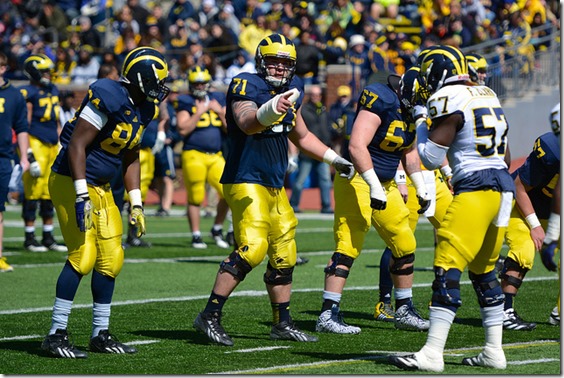





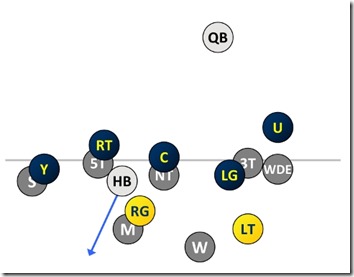

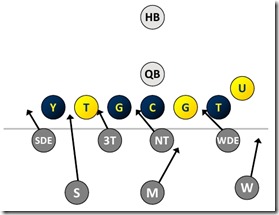
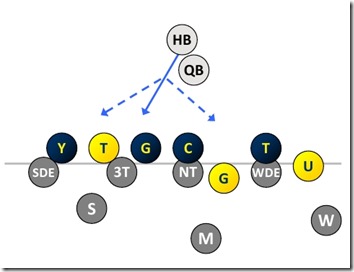

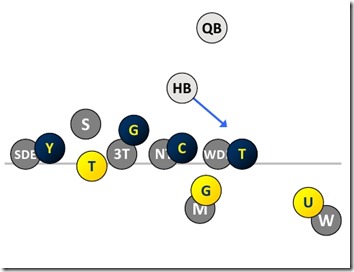
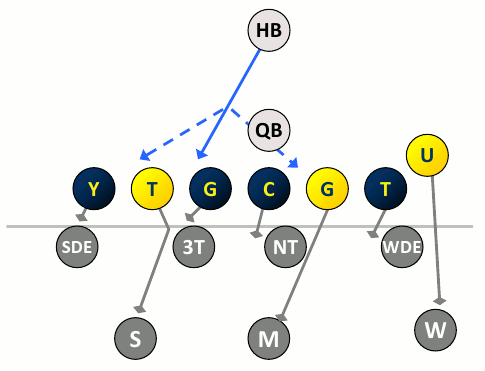
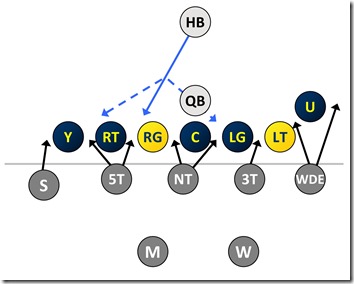



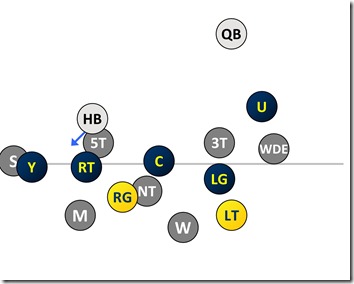
Comments